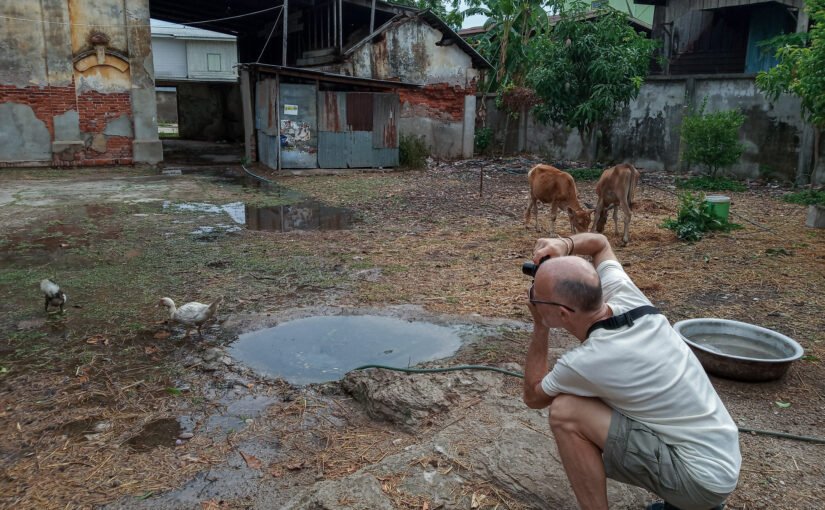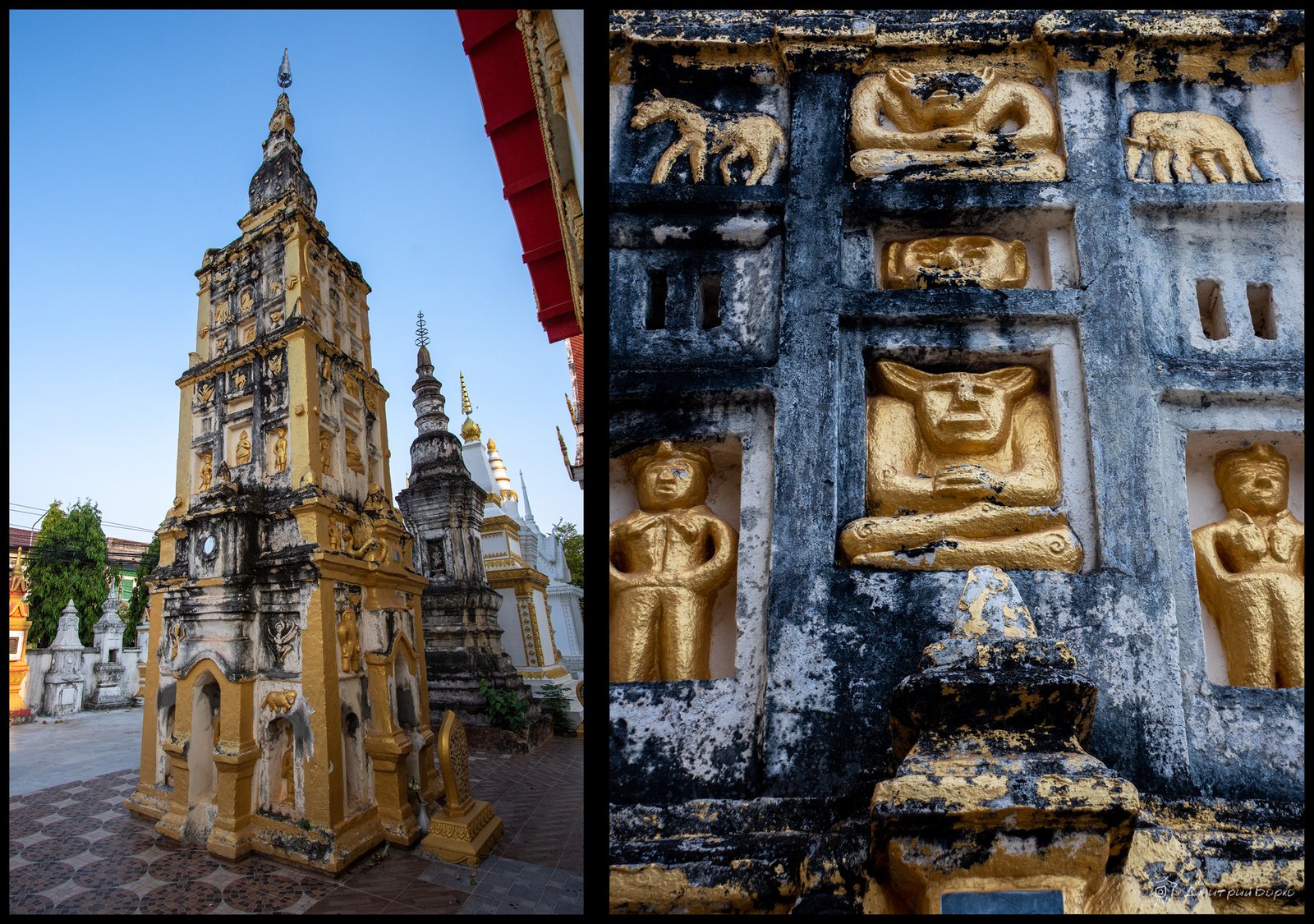Savannaket is a small city, and its historical center is even smaller. This is especially pleasant for tourists: on an area of half a square kilometer you can find about a hundred old buildings and a lot of illustrations on the theme of the connections and mutual influence of Asian and European cultures. In a couple of hours without much stress, you will see all the sights, even transport is not needed.
Like any classic Asian city, Sawan lives in momentary life. Any structure constantly adapts to it, acquiring extensions, fences, remodeling and changing its functions on the go. This is similar to how rapidly nature occupies any housing abandoned by man in a hot climate. If you do not take care of preserving the historical appearance, the city turns into a kind of Angkor Wat – in its own way a beautiful, but sad ruin. This is not to say that Savannaket has been taken care of a lot in recent years. However, it still has a lot to say, and you can still see its fading beauty.

So, the second most populous city in the country owes its existence and its rather short but curious history exclusively to the “damned imperialists.”
Having gained control over Laos in 1893, the French founded Savannaket literally in an open field, next to a small village that existed here on the banks of the Mekong. It was located north of the current historical center, closer to the Friendship Bridge and looked something like this:
Or maybe not. In those days, villages were built only from wood, there was an official ban on that, only temples could be made of stone. The service life of wooden structures in a hot climate is not long – 80 years, even with good care and protection against termites. So it’s not worth looking for the very, very old houses.
The first French buildings on the border of the 19th and 20th centuries. there were long one-story brick barracks and administrative buildings of the “barracks” type. Some of them were later converted into schools that are still operating today.
The “core” of Savannaket, the site of the earliest development, lies south of the central Talat Yen Plaza (on which the cathedral stands), along the road leading south to Pakse. The map shows that the coastal streets are lined right along the line. It is here that there is a whole scattering of long one-story houses. Some are quite simple, others already bear the signs of the “colonial style”, which we will talk about later. One is now the oldest school in the city, another is occupied by a local museum, others are boarded up and stand idle. Opposite the museum, by the way, there is a small street coffee shop with pleasant music and delicious drinks.
From the side of the river there is a large hospital complex, on the territory of which there are also many old French buildings. Barracks-Church-Administration-Hospital-School – this is a classic set of colonial buildings, found wherever the empire comes. The houses creeping along the road are covered with a shadow from a beautiful alley. Trees were clearly planted during development precisely for the sake of this shade. Over the past time, they have become huge and regularly carry out their service, only those people and that life have long been gone.
Since the locals did not know how to build brick houses, the French invited Vietnamese builders. By the way, neighboring Thailand in those days also often used their skills. It seems that, fulfilling the “government order”, they managed to rebuild housing for themselves. In any case, the two streets following from the river bear a clear “Annamite” trace. There is a small old temple and the building of the Vietnam-Lao Friendship Association, and the decorative details of some of the buildings are suggestive. The main Vietnamese temple, of a more modern construction, stands a couple of streets further from the river and a marvelous lion lives on its gates, which you should definitely look at.
After barracks and simple housing for civilians, they began to build something more substantial, reproducing classic European houses. The best example is the governor’s residence. The mansion can be found by walking along the coast outside the hospital. Now this is a typical “abandonment”. Being in the territory of a modern spa resort, it stands without much supervision. The doors were not locked, many of the shutters were thrown open, and the tiles on the ground floor stood on end. So far, the house is in decent condition due to the fact that there used to be a museum here, but hurry: either they decide to do something with it, or it just starts to crumble (more photos).
An alley above the main old road stands another marvelous European-style house. They say that under the French it was counterintelligence. Now on the ground floor there is a cafe and a pizzeria with cozy tables in a shady courtyard. Inside, you can still see the remnants of old decorations on the walls and stylish retro wiring. The Asian motif in the decor of the building is already noticeable, but so far only in the form of green lotuses on the ventilation openings, rather reminiscent of European Art Nouveau. On the other hand, the orange house next to it already has a strong Chinese influence, and the brand on it is in the form of a stylized hieroglyph that brings good luck to the house, which holds in its teeth … a bat!
Two factors were important for the development of the city. Firstly, Savannaket became one of the centers of French administration and trade in southern Laos (it was planned as an important port on the Mekong trade route connecting all French territories – Vietnam, Cambodia and Laos). In an effort to develop the city as quickly as possible, the French made it a duty-free shopping area. Thanks to this, export tobacco, alcohol, perfume, chocolate, clothing and other goods turned out to be cheaper than in neighboring (across the river) Thailand. Secondly, realizing that now merchants and other people will pour in here, it was decided to control the chaotic development and for this to develop a new general style, quite simple (you need to build quickly), but expressive.
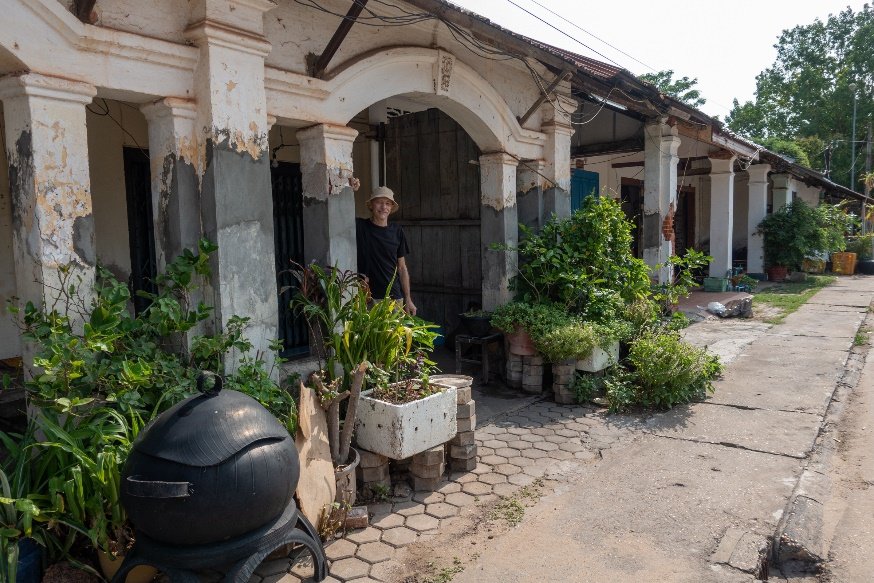
In 1921, the architect and archaeologist Ernest Hébrard was appointed “Chief Building Inspector”. He created a distinctive French colonial style that combined European architectural elements (columns, floor-to-ceiling windows, shutters) with an Asian building system adapted to the local climate. So there were wide galleries and balconies in a circle to protect the walls from the sun and showers, the principles of through ventilation – hinged doors connecting all the rooms, multi-pitched roofs borrowed from Buddhist temples and typical Lao wooden lattices with a pattern.
The central square-Talat Yen boulevard is already built up mainly with two-story houses and looks relatively solid. If you look closely, you can see that the houses have a lot in common – arches, patterns on the galleries, ventilation holes under the roof. One of the buildings bears the date 1930 and an inscription in Vietnamese next to it.
At the end of the boulevard rests on the Catholic Cathedral. Go there in the evening – if possible, you can hear the interesting singing of local parishioners.
These are mainly “custom” buildings designed by Europeans. The construction of shopping malls and private residential buildings was completely at the mercy of the Vietnamese. They built them quite in the oriental spirit: a long building, divided into user sections. If it is two-story, then the first floor is a shop, workshop or restaurant, the second is for living. The lower room is covered with wooden accordion doors, if they are moved apart, a hall without a front wall is formed.
It is interesting that this type of house-gallery is still preserved, only building materials and decor are changing.
Chinatown in the city feels to the left of the cathedral. There are several temples and a large old Chinese school.
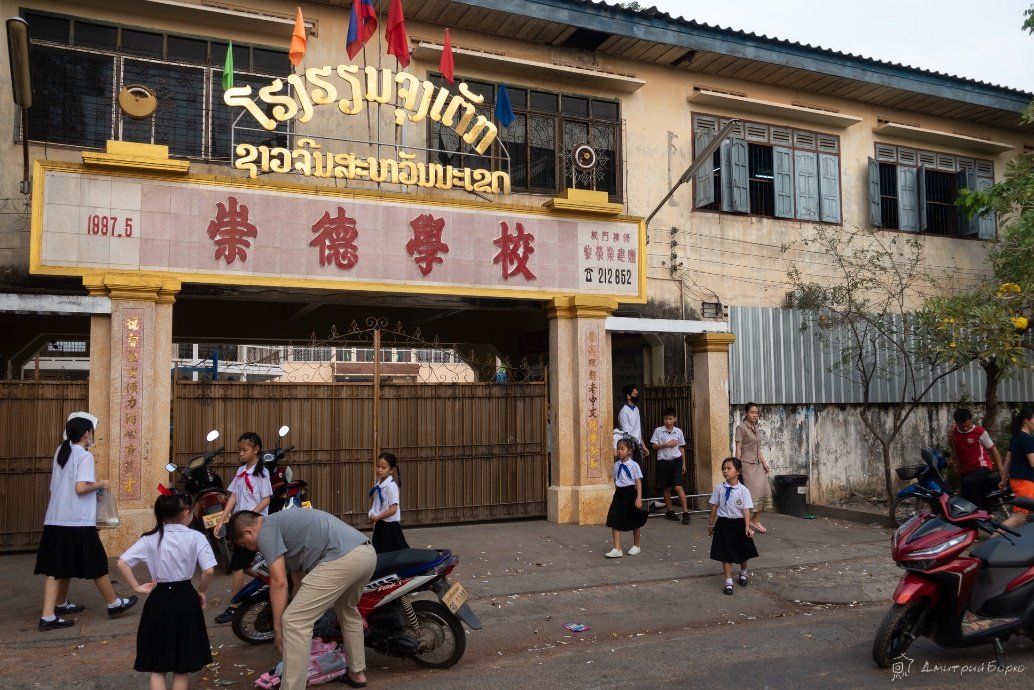
Gradually, Savannaket became like a layered cake. Despite all the attempts of the French to create a system, he stubbornly stuck to his Asian line. Another “layer” of the city are traditional Lao wooden houses, which can be found here and there in the intervals between stone buildings. They are very simple in shape – cubes on high wooden “legs”, often in addition to the residential “box” there is an open veranda.
Piles were needed here to protect against floods and all sorts of creeping and running creatures, and cattle were kept in the shade under the bottom of the house. Since brick became available, and cows and pigs were not very popular in the city, over time, the first floor began to be built of stone or simply laying existing piles with bricks. And instead of a cow, you can keep a car under the house. By the way, a typical local trick is to paint the shutters and doors blue. Sometimes even the whole house can be painted.
As for the Laotian temples, in the old part, the one that stands right by the river, where a huge figure of Naga, a magic snake living in the waters of the Mekong, rises on the embankment. On the territory of the vada (temple) there is a stupa from around 1920, decorated with characters from the heroic Lao epic San Sinsai (try to find the Elephant Man and the Shell Man among them). And on the basement of one of the temple buildings there are bas-reliefs of fabulous and quite real animals. Some of them are clearly representatives of the local fauna, but what the camel and rhinoceros are doing there is not clear. Apparently just like the artist.
The French began to leave gradually, from the end of the 40s, but already in 1951 the government of semi-independent Laos allowed the opening of cooperatives selling American goods and generally developing economic cooperation. By this time, a war begins to flare up in the country, which in one form or another will continue until 1975. There are no traces of it in the city, only a bomb body, for some unknown reason, placed in front of the gates of a private house, and a couple of old guns in the courtyard of the local museum, that’s all the artifacts of that time.
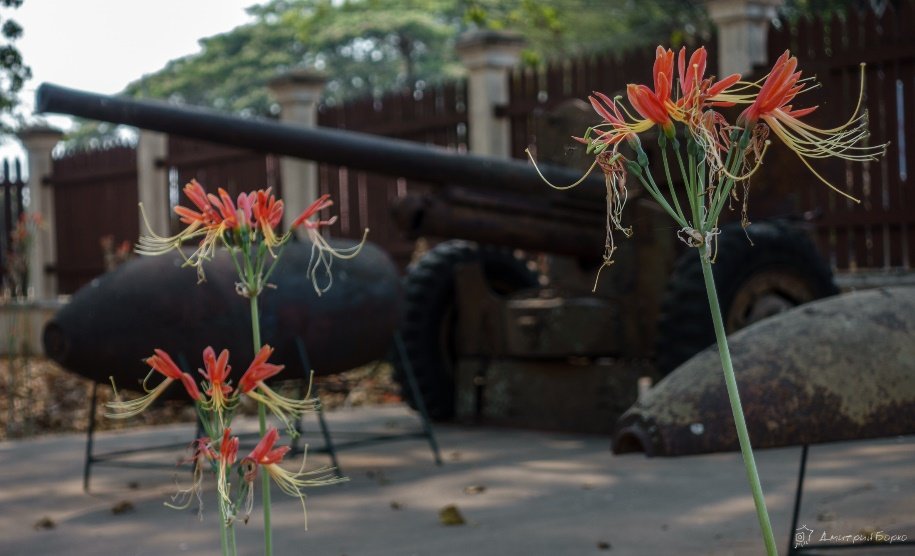

But, oddly enough, it was then that another construction boom began in Savannaket. Walking through the old center, here and there you notice a lot of quite modern houses built according to the Western avant-garde fashion of the 60s. They are completely different from everything that has been built here so far.
On a small patch, almost opposite each other, there are two huge, much higher than the old “French” houses, a cinema (there were 4 of them in a small town!). One of them, “Lao Charoen Rama”, was the “heart” of a large project. It can be seen that a whole microdistrict was planned around with residential buildings, shops, a dance floor and bars (all photos).
The cinema was so popular that its name became the headline of a memoir by a Thai writer known by the pseudonym Lek Baimiang (เล็ก ใบเมี่ยง). He spent his childhood in Savannakhet and studied at the same Chinese school.
Lek says that in the early 70s, Savannakhet was the center of civilization not only for Laos, but also for neighboring Thai regions. Thais came here to have fun and buy trendy western clothes, including real jeans. American soldiers relaxed in the city, drank in local bars, and after watching American films about the Vietnam War, he recognized the familiar atmosphere.
Now they are trying to revive the abandoned cinema complex: several cafes and bars have opened there, and local artists are organizing exhibitions in empty premises. It is difficult to say how much this resonates with the writer’s memories, but the dilapidated interiors give a rather bizarre and very “cinematic” feeling to what is happening.
Cinemas were for local children the main window to the big world (here are photos of the second cinema, Khounsavan).
“At that time, we were most fond of Shaw brothers’ kung fu films and Indian ones. The beauty of the Indian ones was that they didn’t do subtitles at that time, so before the start of the screening, the content of the film was retold in Lao. Naturally, each narrator was free to interpret the plot in his own way and bring his own colors to it. As for the music, there were no less records here than in Bangkok, which was then fashionable, so we were familiar with rock and roll and, yes, we knew the Beatles quite well!”
 We found a poster of the Beatles on the wall in a cafe with the symbolic name “1966”. It is located directly opposite the Khunsavan cinema and it is easy to imagine how people after the session came here to drink a cup of coffee or a glass of French wine.
We found a poster of the Beatles on the wall in a cafe with the symbolic name “1966”. It is located directly opposite the Khunsavan cinema and it is easy to imagine how people after the session came here to drink a cup of coffee or a glass of French wine.
In addition, throughout the city (not just in the oldest part of it), private mansions with clear signs of 60s modernism are scattered: built using concrete and metal, rich in geometric shapes, asymmetries and oblique lines, decorated with concrete panels. Some clearly absorbed the ideas of the Bauhaus and Corbusier at the same time as traces of the colonial style, but all this is adapted to the local climate. We do not know who built them and for whom, but many houses are similar to dilapidated villas in the resort villages of Cambodian Kep, built at the same time. It is surprising that if the avant-garde movement in Cambodia of the 50-60s, called the “New Khmer Architecture” is described and studied, then we could not find any information about very similar analogues in Laos. But they exist!
Another trace of the modern 1960s is the rounded-cornered apartment buildings at many intersections. This also shows an attempt at further planning and development of the city, which, alas, was not completed. It is felt that people made serious plans for the future, but they were given only 15 years.
 The last time the historical role of Sawan was manifested in the fact that the future first General Secretary of the Communist Party of Laos Kayson Phomvihan was born here (his house-museum is located in the city). In his honor, already in the 2000s, the city was renamed to Nakhon Kaisong Phomvihan. In 1975, the Communist Party came to power and set a course for “transition to socialism bypassing the capitalist stage.”
The last time the historical role of Sawan was manifested in the fact that the future first General Secretary of the Communist Party of Laos Kayson Phomvihan was born here (his house-museum is located in the city). In his honor, already in the 2000s, the city was renamed to Nakhon Kaisong Phomvihan. In 1975, the Communist Party came to power and set a course for “transition to socialism bypassing the capitalist stage.”
Cinemas closed one by one. Young people were forbidden to wear jeans. Many active residents of the city – owners, merchants, entrepreneurs – left it, fleeing some to Thailand and some to the West. Savannaket fell into a lethargic sleep for decades. Since then, nothing new has been added to the historical part of the city, the old buildings gradually fell into disrepair or changed almost beyond recognition.
According to Lek Baiming (his family also fled to Thailand), some of the abandoned houses were handed over to the military and new officials. The sad irony is that thanks to this, the old buildings are more or less well preserved. “If it wasn’t, they would have been demolished a long time ago or sold to an investor,” says Lek.
A few years ago, Lek returned to Savan, opened a cafe and hotel, and came up with the annual Savan Fun Fest. His main idea was the revival of the city through culture and interest in history. Things went smoothly, but then the covid collapsed, so in the spring of 2023 we found 2/3 of the cafes and shops of the city closed, and cultural programs were almost curtailed. However, the city authorities are making efforts to revitalize the old city.
We would like to finish our story with something good. In 2022, with the patronage of the municipality, interesting street art appeared in the old town. Its authors, local artists, are confident that, with due diligence, Sawan can also be turned into a real “museum city”, popular for tourism, like Malaysian Georgetown, Lao Luang Prabang, Thai Songkhla or Vietnamese Hue. And the old center still deserves it.
